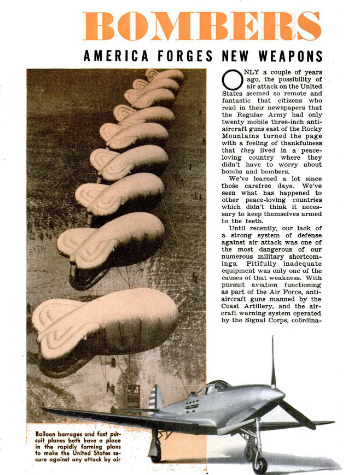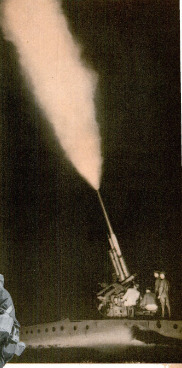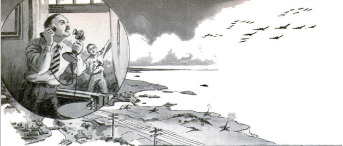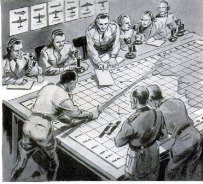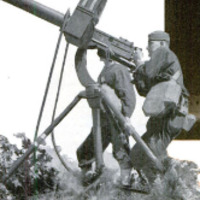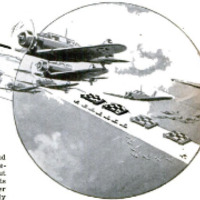-
Title (Dublin Core)
-
Bombers beware!
-
Article Title and/or Image Caption (Dublin Core)
-
Bombers beware!
-
extracted text (Extract Text)
-
ONLY a couple of years |
ago, the possibility of
air attack on the United
States seemed so remote and |
fantastic that citizens who
read in their newspapers that
the Regular Army had only |
twenty mobile three-inch anti-
aircraft guns east of the Rocky |
Mountains turned the page
with a feeling of thankfulness |
that they lived in a peace-
loving country where they
didn't have to worry about
bombs and bombers.
We've learned a lot since
those carefree days. We've |
seen what has happened to
other peace-loving countries
which didn't think it neces-
sary to keep themselves armed |
to_the teeth.
Until recently, our lack of |
a strong system of defense |
against air attack was one of |
the most dangerous of our |
numerous military shortcom- |
ings. Pitifully inadequate |
equipment was only one of the
causes of that weakness. With
pursuit aviation functioning
as part of the Air Force, anti-
aircraft guns manned by the |
Coast Artillery, and the air-
craft warning system operated
by the Signal Corps, codrdina- |
tion was impossible. Early this year
a long forward stride was taken by
the organization of an Air Defense
Command for the northeastern sec-
tion of the country. Now, for the first
time, all the means and methods of
air defense have been placed under
the direction of a single officer—
Brigadier General James E. Chaney.
Although so far his Command has
operated principally on an _experi-
mental basis, it is expected that the
methods it has developed will be
adopted as a much-needed nation-
wide air-defense system. -
In air defense, as in almost every
other operation of present-day war-
fare, time is the determining factor.
Bombers fly about 250 miles an hour,
and pursuit aviation must have warn-
ing of their approach in time to get
off the ground and into position to
intercept them before they reach
their objective.
Of course, the defense can save
time by keeping its planes in the air
instead of on the ground, but because
only a small part of a patrol force
can be in the air at any given time,
and because the average of visibility
from an airplane is only about five
miles, this system is both ex-
pensive and inefficient.
After planes on the ground
receive warning of the ap-
proach of raiders, it takes
them five minutes to get into
the air. Although the fast
fighters used for pursuit-inter-
ception work climb rapidly, it
takes them between five and
seven minutes to reach the
16,000-foot (or higher) alti-
tude at which they usually
operate. To have the best
chance of doing their job of
shooting down or driving away
the attackers before they reach
the bomb-release line—which
for fast bombers flying at be-
tween 15,000 and 20,000 feet
is about two miles short of the target—
the fighters must have about ten minutes
of combat time. That means that they
‘must fly out at least forty miles to meet the
attack, and that they should be warned of
the approach of hostile planes while they
are at least 100 miles away.
SEVERAL large-scale tests have proved
that an aircraft-interception net com-
posed of volunteer civilian observers can be
depended on to give timely warning of the
approach of hostile airplanes to cities or
other objectives located at least 100 miles
from the seacoast or a land border. With
the codperation of commercial telephone
companies and the American Legion, the
Air Defense Command now is organizing
such a net to cover the entire northeastern
portion of the country from Duluth Minn,
eastward to the Maine coast and as far
south as Norfolk, Va., Observation posts—
which are the observers’ homes—are six or
eight miles apart, and as from six to eight
observers are needed for each post, for
twenty-four-hour duty, several hundred
thousand citizens will be signed up for this
patriotic service.
The operation of the system is simple.
When an observer sees or hears airplanes
he picks up his telephone, says “Flash!”
and gives his phone number. The central
routes his call over trunk lines to the
nearest Army information center. A voice
at the other end of the wire says: “Army—
go ahead.” Using a printed message form
as a guide, the observer then gives the
direction and approximate distance of the
planes from his post, the exact time he saw
or heard them, and whatever information
he can about their number, type, and alti-
tude. As successive reports come into the
information center the positions of the
planes are plotted, and from these plottings
their course and speed are determined. This
information, flashed to the officer command-
ing the defending pursuit aviation, enables
him to get his planes off the ground in time
to meet the expected attack, and then to
keep his flyers informed by radio of the
position of the attackers and the direction
in which they are flying. Tests have shown
that the average time which elapses be-
tween the moment when an observer spots
a plane and the moment
its position is plotted in
the information center,
is less than three min-
utes.
To aid in the defense
of cities, fortifications,
and vitally important in-
dustrial areas located
close to our coasts or
land borders, the Signal
Corps has developed an
aircraft detector which
is far in advance of any
similar instrument used
by any foreign power.
fully developed its use may make possible
deadly “blind” gunfire on unseen airplanes.
One Signal Corps company equipped with
this remarkable device now is attached to
the Air Defense Command. As soon as the
necessary detectors can be built, four mobile
Aircraft Warning Service companies, each
with cquipment for five or more mobile sta-
tions, will be organized for service with our
field army and, if necessary, on our land
borders. Six permanent warning stations
are to be established on the Atlantic Coast,
one on the Gulf Coast, and three on the
Pacific Coast, and an undisclosed number
in the Panama Canal Zone and in Alaska,
Hawaii, and Puerto Rico.
GETTING defending planes off the ground
in good time usually means that the at-
tackers will suffer considerable loss and
damage before they reach their objective,
but some of them are pretty certain to get
through, and they must be dealt with by the
antiaircraft artillery—the sky gunners who
form the final protective line of air defense.
No nation has, and in all probability no
nation ever will have, enough antiaircraft
guns to provide this form of close-in pro-
tection for all its cities and all its im-
portant military and industrial installa-
tions. Most of our sky guns are motorized
and so can be moved from place to place,
-
Language (Dublin Core)
-
eng
-
Date Issued (Dublin Core)
-
1940-11
-
pages (Bibliographic Ontology)
-
60-63
-
Rights (Dublin Core)
-
Public domain
-
Archived by (Dublin Core)
-
Sami Akbiyik
-
Marco Bortolami (editor)
 Popular Science Monthly. v. 137, n. 5 1940
Popular Science Monthly. v. 137, n. 5 1940

